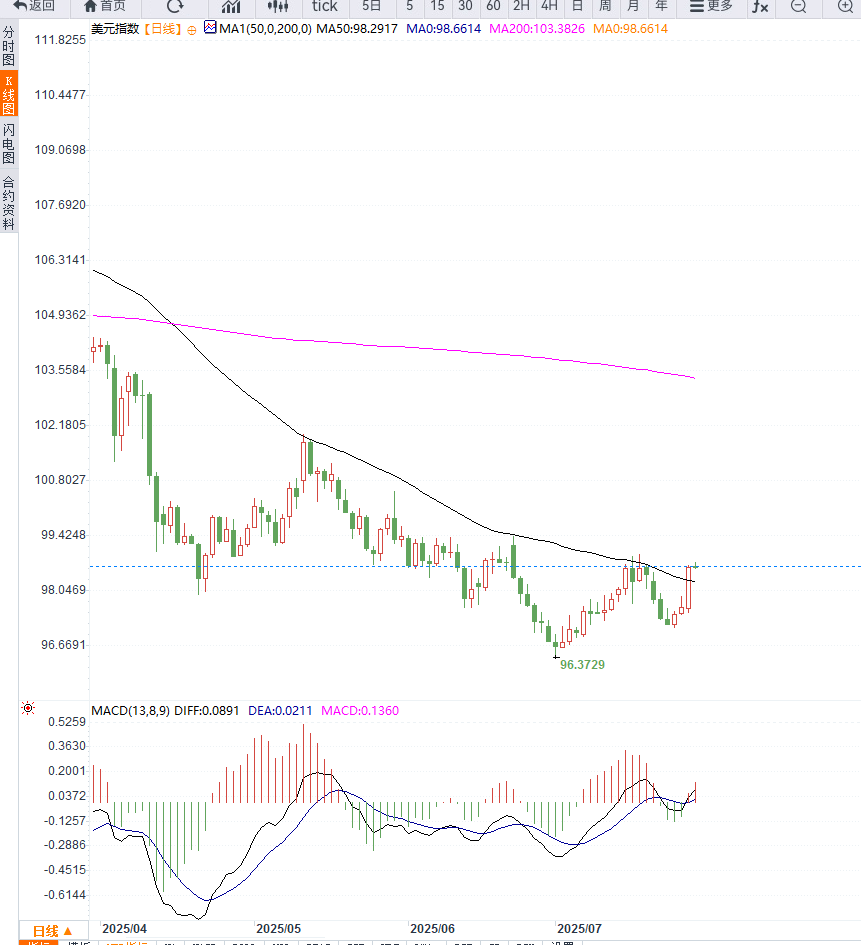Global trade sentiment picks up, and the US dollar index rebounds from a low level
2025-07-29 13:21:56
The core driving force behind this round of gains came from the latest trade agreement signed between the United States and the European Union, which included a 15% tariff on most EU goods from August 1. This news effectively eased previous trade concerns and boosted market confidence in the dollar.
According to market research, the US-EU agreement is seen as one of the few substantive trade breakthroughs in recent times, which will help stabilize cross-border supply chains and corporate expectations.

Negotiations between the Asian giant and the United States have resumed, but Trump's pressure strategy remains. More than five hours of closed-door talks were held in the Swedish capital Stockholm on Monday, and the talks are scheduled to continue on Tuesday. This arrangement has caused investors to pay attention to whether the two sides can overcome key differences.
However, US President Trump also warned that countries that refuse to participate in bilateral negotiations may face punitive tariffs of up to 15% to 20%, much higher than the 10% level set in April.
Trump said on social media on Monday that he had instructed his trade team to restart trade negotiations with Cambodia and Thailand in view of the positive attitudes of the two Asian countries after the two countries ended the border conflict. "The end of this conflict has saved thousands of lives, and we will promote prosperity with peace," he said in a statement.
Analysts at economic consulting firm ING pointed out: "The United States is currently showing a two-track strategy on trade issues. On the one hand, it puts pressure on non-negotiating countries, and on the other hand, it quickly promotes strategically significant bilateral agreements in an attempt to strengthen the global dominance of the US dollar."
The Fed's policy outlook has become the next focus of the market. The Fed will announce its latest interest rate decision on Wednesday, and the market generally expects it to maintain the benchmark interest rate in the range of 4.25% to 4.50%.
Nonetheless, traders will be closely watching the press conference following the Federal Open Market Committee (FOMC) meeting for signals on whether a rate cut cycle will be initiated in September.
In addition, the U.S. second quarter core personal consumption expenditures (PCE) inflation data and July non-farm employment data will also be released this week. These data will provide key references for the health of the economy and the path of monetary policy.
From the technical pattern of the daily chart, the US dollar index (DXY) maintains a steady upward channel. The current price is firmly above the 20-day and 50-day moving averages, indicating that the short-term and medium-term bullish trend is intact. The MACD indicator continues to expand above the zero axis, and the momentum column is strengthened, indicating that buying power dominates the market.
If DXY successfully breaks through the previous high of 98.85, the next target will be the psychological barrier of 99.20; on the contrary, the short-term support is near 98.20, and if it falls below it, it may trigger a pullback to test the 97.80 area. Overall, the structure of the US dollar index is strong, and the key to the subsequent trend lies in the coordination between the Fed meeting and economic data this week.

Editor's opinion:
The current strength of the US dollar not only benefits from the positive stimulus of the short-term trade agreement, but also reflects the expectation of the Federal Reserve to maintain a high interest rate policy and the continued inflow of safe-haven funds. The short-term bullish trend is strong, but it has not reversed. It is necessary to wait for the fundamentals to give further clear direction guidance and wait for stress testing.
- Risk Warning and Disclaimer
- The market involves risk, and trading may not be suitable for all investors. This article is for reference only and does not constitute personal investment advice, nor does it take into account certain users’ specific investment objectives, financial situation, or other needs. Any investment decisions made based on this information are at your own risk.





















